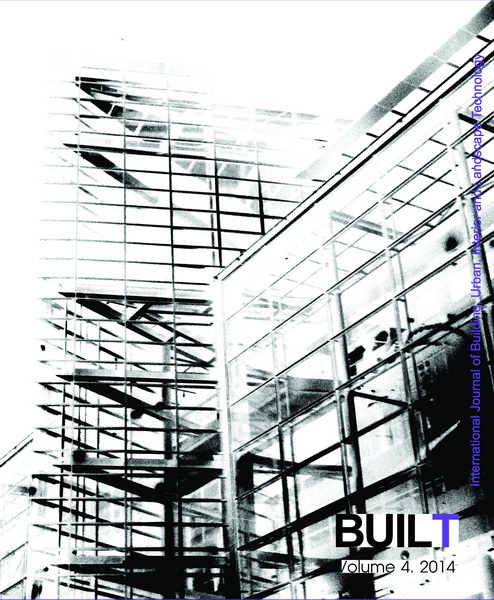A Field Investigation of Air Infiltration Rates through Automatic Entrance Doors in Retail Buildings
DOI:
https://doi.org/10.56261/built.v4.170259Keywords:
Air infiltration, Automatic entrance door, Retail buildingAbstract
his paper presents field investigations of air infiltration rates in twelve big-box retail stores and two small grocery stores located in two different climate zones: hot and humid (zone 2a) and moderate to cold (zone 5a) climates. The investigations of the entrance door characteristics, differential pressures across the automatic entrance doors, and number of people using the doors per hour were used to calculate transient air infiltration rates through various types of automatic entrance doors. It was found that the calculated air infiltration rates for retail stores and supermarkets ranged from 40 L/s to 5,800 L/s. Normalized by the door area, the range of air infiltration rates through the automatic entrance door for a supermarket was from 100 L/s.m2 to 3,000 L/s.m2, which was greater than the range previously observed in retail stores from 100 L/s.m2 to 1,100 L/s.m2. In terms of air exchange rates, the air infiltration rates through the automatic entrance doors for small stores, especially in supermarkets and grocery stores, had a larger impact than those rates found in the big-box retail stores due to the size of building volume.
Downloads
References
American Society of Heating, Refigeration and Air- Conditioning Engineering [ASHRAE]. (2010a). Ventilation for acceptable indoor air quality. ASHRAE Standard 62.1-2010. Atlanta, GA: Author.
American Society of Heating, Refigeration and Air- Conditioning Engineering [ASHRAE]. (2010b). Energy standard for buildings except low-rise residential buildings. ANSI/ASHRAE/IES Standard 90.1-2010. Atlanta, GA: Author.
Bennett, D., Apte, M., Wu, X., Trout, A., Faulkner, D. & Sullivan, D. (2011). Indoor environmental quality and heating, ventilating, and air conditioning survey of small and medium size commercial buildings: Field study (No. CEC-500-2011-043). California Energy Commission. Retrieved from http://www.energy.ca.gov/2010publications/CEC-500-2010-050/CEC-500-2010-050.pdf
Bennett, D. H., Fisk, W., Apte, M. G., Wu, X., Trout, A., Faulkner, D. & Sullivan, D. (2012). Ventilation, temperature, and HVAC characteristics in small and medium commercial buildings in California. Indoor Air, 22(4), 309–320. doi:10.1111/j.1600-0668.2012.00767.x
Chan, W., Sidheswaran, M., Sullivan, D., Cohn, S. & Fisk, W. (2012). Contaminant levels and source strengths in US retail stores-A pilot study (No. LBNL 5547E). Retrieved from http://eande.lbl.gov/sites/all/files/publications/lbnl-5547e_0.pdf
Chao, C. Y. & Chan, G. Y. (2001). Quantification of indoor VOCs in twenty mechanically ventilated buildings in Hong Kong. Atmospheric Environment, 35(34), 5895- 5913.
Cho, H., Gowri, K. & Liu, B. (2010). Energy saving impact of ASHRAE 90.1 vestibule requirements: modeling of air infiltration through door openings (A report for the U.S. Department of Energy No. PNNL-20026). Pacific Northwest National Laboratory. Retrieved from http://www.osti.gov/bridge/servlets/purl/1017117-phV5aG/
Hotchi, T., Hodgson, A. T. & Fisk, W. J. (2006). Indoor air quality impacts of a peak load shedding strategy for a large retail building (No. 59293). Lawrence Berkeley National Laboratory, Berkeley, CA.
Kohri, K. (2001). A simulation analysis of the opening area of entrance doors and winter airflow into the entrance hall of a high-rise office building. In Building Simulation. Rio de Janeiro, Brazil.
McGowan, A. (2006). Heat transfer through roll-up doors, revolving doors and opaque nonresidential swinging, sliding and rolling doors (ASHRAE research project No. RP-1236). Levelton Consultants Ltd.
National Renewable Energy Laboratory [NREL]. (n.d.). Retail building guide for entrance energy efficiency measures. Retrieved October 21, 2014, from https://buildingdata.energy.gov/cbrd/resource/1067
Persily, A. K. & Ivy, E. M. (2001). Input Data for Multizone Airflow and IAQ Analysis (No. NISTIR 6585). NIST.
Siegel, J. A., Srebric, J., Crain, N., Nirlo, E., Zaatari, M., Hoisington, A., Shu S., Jareemit, D. & Kim, Y. S. (2013). ASHRAE Research Project 1596-RP: Ventilation and indoor Air Quality in Retail Stores (No. RP1596). American Society of Heating, Refrigerating and Air-Conditioning Engineers.
Srisuwan, P. & Varodompun, J. (2013). Field CO2 monitoring of rooms with differnt air-tightness classes and ventilation system. International Journal of Building, Urban, Interior and Landscape Technology, 2, 5-20.
Wargocki, P., Fanger, P. O., Krupicz, P. & Szczecinski, A. (2004). Sensory pollution loads in six office buildings and a department store. REHVA Scientific, 36(10), 995- 1001. doi:10.1016/j.enbuild.2004.06.006
Wu, X., Apte, M. G., Maddalena, R. & Bennett, D. H. (2011). Volatile organic compounds in small and medium-sized commercial buildings in California. Environmental Science & Technology, 45(20), 9075- 9083. doi:10.1021/es202132u
Yuill, G. K. (1996). Impact of high use automatic doors on infiltration (ASHRAE research project No. RP-763) (p. 150 pages). Architectural Engineering Department, Pennsylvania State University.
Yuill, G. K., Upham, R. & Hui, C. (2000). Air leakage through automatic doors. ASHRAE Transactions, 106 Part 2, 145-160.
Downloads
Published
How to Cite
Issue
Section
License

This work is licensed under a Creative Commons Attribution-NonCommercial-NoDerivatives 4.0 International License.












